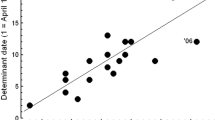Abstract
We studied the occurrence of laying gaps in free-living populations of the pied flycatcher, Ficedula hypoleuca, and the great tit, Parus major, in a pollution gradient of a copper smelter in south-west Finland. Laying gaps were 2.8 times more common in F. hypoleuca than in P. major. The probability of laying gaps was highest in the heavily polluted zone and lowest in the unpolluted zone for both bird species. Cold weather at the time of laying increased the number of laying gaps in both species, but in P. major this effect was most pronounced in the heavily polluted environment. In the most heavily polluted environment the laying gaps were more likely to occur near the beginning of the laying sequence in both species. The laying gap probability increased with increasing laying date in P. major but not in F. hypoleuca. We suggest that the increased number of laying gaps in the polluted environment results from limited Ca availability and the interference of heavy metals with Ca metabolism in laying females.




Similar content being viewed by others
References
Bryant DM (1975) Breeding biology of house martins Delichon urbica in relation to aerial insect abundance. Ibis 117:180–216
Bureš S, Weidinger K (2003) Sources and timing of calcium intake during reproduction in flycatchers. Oecologia 137:634–641
Cramp S, Perrins CM (1993) The birds of the western Palearctic. Oxford University Press, Oxford
Dauwe T, Janssens E, Pinxten R, Eens M (2005) The reproductive success and quality of blue tits (Parus caeruleus) in a heavy metal pollution gradient. Environ Pollut 136:243–251
Derome J, Nieminen T (1998) Metal and macronutrient fluxes in heavy-metal polluted Scots pine ecosystems in SW Finland. Environ Pollut 103:219–228
Dhondt AA, Eykerman R, Huble J (1983) Laying interruptions in tits Parus spp. Ibis 125:370–376
Eeva T, Lehikoinen E (1995) Egg shell quality, clutch size and hatching success of the great tit (Parus major) and the pied flycatcher (Ficedula hypoleuca) in an air pollution gradient. Oecologia 102:312–323
Eeva T, Lehikoinen E (1996) Growth and mortality of nestling great tits (Parus major) and pied flycatchers (Ficedula hypoleuca) in a heavy metal pollution gradient. Oecologia 108:631–639
Eeva T, Lehikoinen E (2000) Improved breeding success in forest passerines after decreased emissions of heavy metals. Nature 403:851–852
Eeva T, Lehikoinen E (2004) Rich calcium availability diminishes heavy metal toxicity in pied flycatcher. Funct Ecol 18:548–553
Eeva T, Lehikoinen E, Pohjalainen T (1997) Pollution-related variation in food supply and breeding success in two hole-nesting passerines. Ecology 78:1120–1131
Eeva T, Ryömä M, Riihimäki J (2005) Pollution-related changes in diets of two insectivorous passerines. Oecologia 145:629–639
Eeva T, Ahola M, Lehikoinen E (2009) Breeding performance of blue tits (Cyanistes caeruleus) and great tits (Parus major) in a heavy metal polluted area. Environ Pollut 157:3126–3131
Gosler AG, Higham JP, Reynolds SJ (2005) Why are birds’ eggs speckled? Ecol Lett 8:1105–1113
Goyer RA (1997) Toxic and essential metal interactions. Annu Rev Nutr 17:37–50
Graveland J (1996) Avian eggshell formation in calcium-rich and calcium-poor habitats: importance of snail shells and anthropogenic calcium sources. Can J Zool 74:1035–1044
Graveland J, Berends AE (1997) Timing of the calcium intake and effect of calcium deficiency on behaviour and egg laying in captive great tits, Parus major. Physiol Zool 70:74–84
Graveland J, Drent RH (1997) Calcium availability limits breeding success of passerines on poor soils. J Anim Ecol 66:279–288
Graveland J, van der Wal R (1996) Decline in snail abundance due to soil acidification causes eggshell defects in forest passerines. Oecologia 105:351–360
Graveland J, van Gijzen T (1994) Arthropods and seeds are not sufficient as calcium sources for shell formation and skeletal growth in passerines. Ardea 82:299–314
Heliövaara K, Väisänen R (1993) Insects and pollution. CRC, Boca Raton
Janssens E, Dauwe T, Pinxten R, Eens M (2003) Breeding performance of great tits (Parus major) along a gradient of heavy metal pollution. Environ Toxicol Chem 22:1140–1145
Kiikkilä O (2003) Heavy-metal pollution and remediation of forest soil around the Harjavalta Cu–Ni smelter, in SW Finland. Silva Fenn 37:399–415
Lessells CM, Dingemanse NJ, Both C (2002) Egg weights, egg component weights, and laying gaps in great tits (Parus major) in relation to ambient temperature. Auk 119:1091–1103
Low M (2008) Laying gaps in the New Zealand stitchbird are correlated with female harassment by extra-pair males. Emu 108:28–34
Nilsson JÅ, Svensson E (1993) The frequency and timing of laying gaps. Ornis Scand 24:122–126
Pulliainen E, Jussila P, Tunkkari PS (1994) Variation in the laying intervals of the pied flycatcher and the redstart. Ornis Fenn 71:109–114
SAS Institute (2003) The SAS system for Windows. Release 9.1. SAS Institute, Cary
Schmidt K-H, Hamann H-J (1983) Unterbrechung der Legefolge bei Höhlenbrütern. J Ornithol 124:163–176
Van Noordwijk AJ, McCleery RH, Perrins CM (1995) Selection for the timing of great tit breeding in relation to caterpillar growth and temperature. J Anim Ecol 64:451–458
Von Haartman L (1990) Breeding time of the pied flycatcher Ficedula hypoleuca. NATO ASI Ser G24:1–16
Wilkin TA, Gosler AG, Garant D, Reynolds SJ, Sheldon BC (2009) Calcium effects on life-history traits in a wild population of the great tit (Parus major): analysis of long-term data at several spatial scales. Oecologia 159:463–472
Winkel W (1970) Experimentelle Untersuchungen zur Brutbiologie von Kohl- und Blaumeise (Parus major und P. caeruleus). J Ornithol 111:154–174
Yom-Tov Y, Wright J (1993) Effect of heating nest boxes on egg-laying in the blue tit (Parus caeruleus). Auk 110:95–99
Acknowledgments
We thank Jorma Nurmi and all the other people involved in the field work over the years. Our study was financed by the Academy of Finland (project 8119367) and Finnish Cultural Foundation.
Author information
Authors and Affiliations
Corresponding author
Additional information
Communicated by Chris Whelan.
Rights and permissions
About this article
Cite this article
Eeva, T., Lehikoinen, E. Polluted environment and cold weather induce laying gaps in great tit and pied flycatcher. Oecologia 162, 533–539 (2010). https://doi.org/10.1007/s00442-009-1468-9
Received:
Accepted:
Published:
Issue Date:
DOI: https://doi.org/10.1007/s00442-009-1468-9




